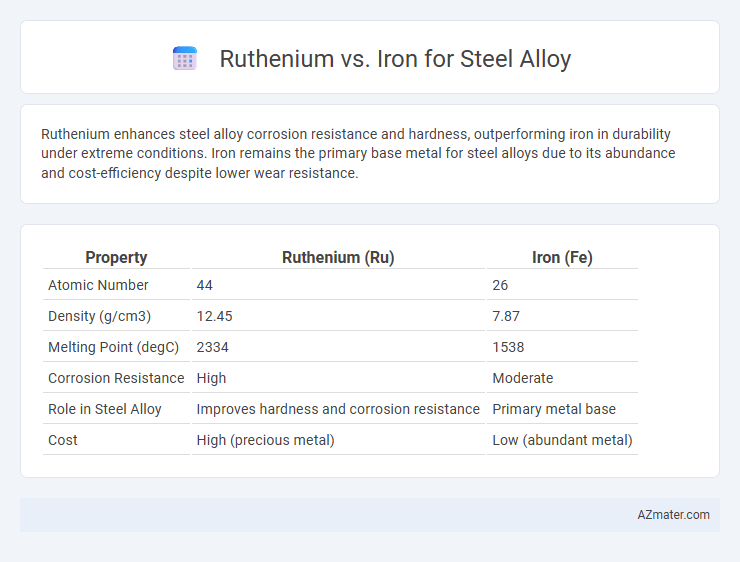Ruthenium enhances steel alloy corrosion resistance and hardness, outperforming iron in durability under extreme conditions. Iron remains the primary base metal for steel alloys due to its abundance and cost-efficiency despite lower wear resistance.
Table of Comparison
| Property | Ruthenium (Ru) | Iron (Fe) |
|---|---|---|
| Atomic Number | 44 | 26 |
| Density (g/cm3) | 12.45 | 7.87 |
| Melting Point (degC) | 2334 | 1538 |
| Corrosion Resistance | High | Moderate |
| Role in Steel Alloy | Improves hardness and corrosion resistance | Primary metal base |
| Cost | High (precious metal) | Low (abundant metal) |
Introduction to Steel Alloys
Steel alloys are primarily composed of iron, which provides the essential magnetic and structural properties needed for a wide range of applications. Ruthenium, a rare transition metal from the platinum group, is used in small quantities as an alloying element to enhance corrosion resistance and hardness in specialized steel grades. The addition of ruthenium improves wear resistance and strength without significantly increasing weight or compromising ductility, making it valuable for high-performance and industrial steel alloys.
Importance of Alloying Elements in Steel
Ruthenium enhances steel alloys by improving corrosion resistance and increasing hardness, making it valuable in high-performance applications compared to iron, which primarily contributes to the base strength and ductility of steel. The inclusion of alloying elements like ruthenium modifies the microstructure, promoting improved wear resistance and stability at elevated temperatures. Optimizing the balance of ruthenium and iron in steel alloys directly impacts mechanical properties and longevity, critical for advanced industrial uses.
Overview of Ruthenium as a Steel Alloying Element
Ruthenium, a rare platinum-group metal, enhances steel alloys by improving corrosion resistance, hardness, and high-temperature stability, making it valuable in specialized industrial applications. Its addition, typically in trace amounts below 1%, refines the microstructure of steel, leading to increased wear resistance and strength without significantly increasing weight. Compared to iron, ruthenium's incorporation optimizes alloy performance under extreme conditions, contributing to advanced steel formulations in aerospace and chemical processing industries.
Overview of Iron’s Role in Steel
Iron serves as the primary base metal in steel alloys, providing essential strength, ductility, and magnetic properties. Its crystalline structure allows for various alloying elements like ruthenium to enhance corrosion resistance and hardness. The versatility of iron in steel manufacturing makes it fundamental for construction, automotive, and industrial applications.
Comparative Chemical Properties of Ruthenium and Iron
Ruthenium exhibits superior corrosion resistance and higher oxidation stability compared to iron, enhancing the durability of steel alloys under extreme conditions. Iron provides excellent magnetic properties and cost-effectiveness, making it a practical base metal, while ruthenium adds hardness and wear resistance due to its noble metal characteristics. The chemical inertness and higher melting point of ruthenium contribute to improved alloy performance in high-temperature applications relative to iron.
Mechanical Performance: Ruthenium vs Iron Alloys
Ruthenium-enhanced steel alloys exhibit superior mechanical performance compared to traditional iron-based alloys, offering increased hardness, tensile strength, and corrosion resistance due to Ruthenium's ability to refine grain structure and improve phase stability. Ruthenium's addition significantly enhances fatigue resistance and high-temperature durability, making these alloys ideal for aerospace and industrial applications requiring prolonged mechanical stress tolerance. Iron alloys, while widely used, generally lack the enhanced wear resistance and strength retention found in Ruthenium-alloyed steels under extreme operational conditions.
Corrosion Resistance: Ruthenium- vs Iron-Alloyed Steels
Ruthenium-alloyed steels exhibit significantly enhanced corrosion resistance compared to traditional iron-based steels due to ruthenium's ability to form stable, passive oxide layers that protect the metal surface. Iron-alloyed steels are more prone to oxidation and rust, especially in aggressive environments, leading to reduced durability and increased maintenance costs. Incorporating ruthenium into steel alloys improves resistance to pitting and crevice corrosion, extending the lifespan of components in industrial and marine applications.
Cost and Availability Considerations
Ruthenium is significantly more expensive and less abundant than iron, impacting its feasibility in large-scale steel alloy production. Iron's widespread availability and low cost make it the primary choice for steel manufacturing, ensuring economic efficiency and consistent supply. Ruthenium, while enhancing certain alloy properties, is typically reserved for niche applications due to cost and scarcity constraints.
Industrial Applications and Use Cases
Ruthenium enhances steel alloy's hardness, corrosion resistance, and high-temperature stability, making it ideal for aerospace and chemical processing industries requiring durable components. Iron-based steel alloys remain dominant in construction, automotive, and infrastructure due to their cost-effectiveness, machinability, and versatility. Ruthenium's application in steel alloys is specialized and limited by cost, favoring niche markets seeking superior performance under extreme conditions.
Future Trends in Steel Alloy Development with Ruthenium and Iron
Future trends in steel alloy development emphasize the strategic use of ruthenium to enhance corrosion resistance, mechanical strength, and thermal stability when combined with iron-based matrices. Ruthenium's ability to improve alloy performance at high temperatures positions it as a critical element in advanced steel formulations for aerospace and energy applications. Innovations in microalloying with ruthenium and iron support the creation of steels with superior durability and reduced environmental impact, aligning with global sustainability goals.

Infographic: Ruthenium vs Iron for Steel Alloy
 azmater.com
azmater.com